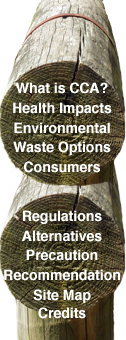Regulations
Responses to APVMA Review
![]() CSIRO
CSIRO
![]() Treated
timber industry
Treated
timber industry
![]() Community
Representatives
Community
Representatives
![]() Need
for Further Research
Need
for Further Research
![]() References
References
The reactions to the APVMA’s review have been varied. The CSIRO’s Forestry and Forest Products division is anticipating improvements in CCA industry safety, including introductions of a test to ensure that treated timber is completely dry before leaving the workshop, and improved awareness through the label changes and a pamphlet on the ‘do’s and don’ts’ for handling treated timber that will be available to all consumers (Cookson, L., Forestry and Forest Products, CSIRO, Pers. Comm., 14/12/04).
The treated timber industry, although they consider the findings to be an ‘over-reaction by the APVMA’, are intending to cooperate. Koppers Arch, the largest timber preserver, states ‘it is now incumbent upon us to comply with our obligations and work through the necessary changes’ (Koppers Arch, 2004). The wine industry, one of the most significant users of CCA-treated timber, is relieved there is no recommendation to limit this use. One of their publications stated ‘many grapegrowers will sigh with relief at this outcome; the continued use of CCA-treated posts in vineyards is assured’ (Smith and Mollah, 2004) as are the significant volumes of hazardous waste from used vineyard stakes.
Community representatives consider that the review has some considerable short-comings arising the fact that the APVMA does not undertake its own research and the limited scope of APVMA’s powers. The majority of chemicals reviewed by APVMA can be adequately managed through variations to their labels. However, many of the environmental and social impacts associated with CCA occur during use and disposal of the products that are treated with CCA, not the CCA itself (Immig, J., APVMA Community Consultative Committee, Pers. Comm., 22/11/04). Varying the label information for CCA may be unlikely to have sufficient impact on the use of wood treated with CCA, and the APVMA has explicitly stated that they have ‘no regulatory authority over existing CCA-treated timber structures’ (APVMA, 2003a, p.31). Nor can they make recommendations regarding disposal of used CCA-treated timber.
This situation requires another authority to develop strong policies to manage these, such as EnHealth, a government body formed under the National Environmental Health Strategy to address both traditional and modern health hazards. The hazards pertaining to the adverse affects of CCA-treated timber, which would be covered by EnHealth, include water pollution from industry and hazardous waste accumulation, although CCA is not currently formally defined as hazardous waste in Australia. State-based environmental authorities should also regulate CCA-treated timber to minimise waste impacts, as the NSW DEC is intending to do under the Extended Producer Responsibility framework (NSW DEC, 2004).
A further concern with the APVMA review is the need for more research. Marianne Lloyd-Smith of the National Toxics Network (Pers. Comm.,1/11/04), is concerned that the APVMA only re-assesses existing data rather than doing its own original research. Its review is therefore hampered by the limitations of the existing studies and a resultant lack of data, which then limits the knowledge base on which the APVMA can make recommendations.
In this review, the APVMA identified data gaps for oral and dermal intake of arsenic related to playground exposure for Australian situations, and in the understanding of whether additional inorganic arsenic dislodged from treated timber surfaces would raise the level of arsenic above an acceptable level. The APVMA has also called for more worker exposure data. However the APVMA is not explicitly concerned about where funding sources for research will come from to close these knowledge gaps, such as epidemiological studies and studies into plant uptake of arsenic into the root tissue (Putcha, S. APVMA, Pers. Comm., 21/12/04).
This situation is further compounded by the lack of available non-industry funding to research bodies such as the CSIRO which have been unsuccessful in attracting research grants or industry contributions for work that may result in limiting the treated timber industry market. As 35% of CSIRO’s research budget comes from industry contributions (CSIRO, 2004), research proposals that may lead to the banning of CCA have not attracted funding from the timber treatment industry.
The CSIRO’s Laurie Cookson has identified a number of research possibilities that would broaden Australia-specific knowledge on the impacts of CCA treated timber. These include leaching trials of treated timber being used in Australian conditions; further research into the issue of spent vineyard stakes; and studies of the uptake of CCA chemicals by oysters. None of these projects have successfully secured funding, and he stated that ‘it is easier to get funding for termite research’. This situation is despite innovations by CSIRO’s forest products laboratory that have resulted in the granite guard against termites; plastic wraps for marine piles that reduce the level of treatment required; and creosote-treated poles covered in plastic to prevent leaching. The knowledge gaps are likely to remain whilst the CSIRO and the universities are reliant on industry funds for expensive and long-term research (Cookson, L., Forestry and Forest Products, CSIRO, Pers. Comm., 14/12/04).
References:
APVMA (2003a), The Reconsideration Of Registrations Of Arsenic Timber Treatment Products (CCA And Arsenic Trioxide) And Their Associated Labels (Review Summary), Australian Pesticides And Veterinary Medicines Authority, Canberra. (pdf - 1.2MB)
CSIRO (2004), CSIRO Annual Report 2003/04, Commonwealth Scientific and Industrial Research Organisation, Canberra.
Koppers Arch (2004), ‘APVMA finally delivers on CCA’ and ‘UK copes with CCA deadline’, Treatment Business News, September, Issue 6, p.1.
NSW DEC (2004), Extended Producer Responsibility Priority Statement, NSW Department of Environment and Conservation, http://www.epa.nsw.gov.au/resources/eprps2004.pdf (accessed 22/11/04).
Smith, T. And Mollah, M. (2004), ‘CCA Review Implications For Viticulture’, The Australian & New Zealand Grapegrower And Winemaker, Ryan Publications, April.


